+212 661 145 518
sahara4x4voyages@gmail.com
Day 1 : Tangier - Chefchaouen : pick-up at the airport in Tanger according to your arrival times; departure to the RIF mountains and the lovely and calm town of Chefchaouen. Chefchaouen or simply 'Chaouen' is a small town with about 40,000 inhabitants, located about 100 km from Ceuta. Surrounded by the Rif mountain chain, Mount Tisouka (2,050 m) and Mount Megou (1,616 m) extend over the city like two large horns. The city is called after these horns as the word 'Chefchaouen' is Berber and means 'See the horns'. Enjoy the products' great variety of colors in stores and souks which provide a startling contrast to the shining white and blue of the houses.
Day 2 : Chefchaouen - Volubilis - Meknes :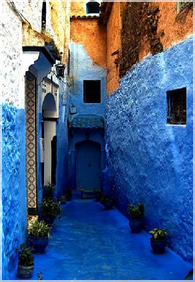
Breakfast. We cross the Rif Mountains and come to the Roman ruins from the 1st century AD called Volubilis before we head of to the imperial city of Meknes, famous for its impressive walls and full blooded Arab horses. 'Meknassa of the olives' – was founded by Berber tribes in the 9th century but it took until 1069 until it developed its actual character under the reign of the Almoravides who built a massive bastion and fortress in the city. After centuries of captures, conquests, releases and reconstructions, Meknes entered its golden age under the reign of Mulay Ismail who appointed it the capital city of Morocco. This sultan from the Alaoui dynasty embellished the city with walls and monumental doors, gardens, mosques, fortresses and an impressive palace, Dar Kebira. It became one of the most monumental cities in Morocco.
Day 3 : Meknes - Fes :
After breakfast, we hit the road for about 30 minutes and arrive in Fes. Founded in the IX century by Idris II, Fes is one of the oldest cities in Morocco and one of the largest cities in the whole Maghreb region. UNESCO declared it world cultural heritage in 1981. The city, divided in 3 different zones, has maintained medieval traditions which were lost in other parts of the world a long time ago, such as the traditional leather tannery. Tannery has existed in Fes for centuries.
Day 4 : Fes - Ifrane - Midelt :
Breakfast. We head off into the Middle Atlas and arrive in Ifrane, an extraordinary town with a cultural heritage dating from the French Protectorate and often called 'the Moroccan Switzerland'. Afterwards we take the route past the original and unspoiled landscape of Morocco, passing by traditional clay houses, nomad and semi nomad villages until we arrive in Midelt. In the first half of the XXth century, this small town was popular for its mineral resources, as the plumb mines that were mainly exploited by the French contributed to its fast economic growth during the Protectorate Era. Today, as the productivity has decreased, Moroccans have mostly abandoned this economic activity. Today, Midelt has become a distribution center for the largest part of fossils sold in Morocco.
Day 5 : Midelt - Imilchil: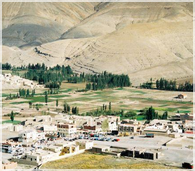
Breakfast. This morning, the transportation will go to the Middle Atlas Mountains where we visit the village of Rich, an important starting point for expeditions into the High Atlas Mountains. We head off in direction to Imilchil, situated about 2,500 m above sea level. The town is very famous for its marriage festival in August and its precious lakes Tislit and Islit. We continue and stop in Agoudal, a beautiful mountain village, full of houses built with clay. Dinner and accommodation in a hostel.
Day 6 : Imilchil - Aguodal - Tinghir : 
We enjoy our breakfast before we had off to the mountain roads. We visit the Ahaiam cave, a historical, Portuguese heritage dating from the 1400. Passing by the beautiful green and ocher colors of the Dades valley we come to the High Atlas Mountains. The Dades valley reminds us of a science fiction scenery as the rock formations' various and lively colors resemble to a moon landscape. You can find numerous Kasbahs in the area which were built centuries ago by the Berber people to protect themselves from the invaders of that time. Arrival in Tinghir.
Day 7 : Tinghir - Erfoud - Merzouga :
After breakfast, we go on a short trip to Tinghir, one of the most beautiful villages in southern Morocco. The nearby Todra gorge, situated in the middle of the mountains in a valley full of palm groves and clay houses, offers one of the most stunning views of Morocco. At its most narrow point the gorge is only about 20 m large and a river with clear and unspoiled water flows through. People in this area are welcoming and friendly and the region is full of Kasbahs and hostels. We continue our trip to Erfoud, our last stop before we start our Sahara tour, leading us to Merzouga and dunes exceeding a height of over 150 m.
Day 8 Merzouga - Merzouga :
We spend the whole day in Merzouga to enjoy the people from the desert and to visit the surroundings, such as the deserted mines of N'tis as well as Kamelia, a village inhabited by people originally from Senegal. In the afternoon, you will have the opportunity to take a camel ride into the dunes, where you can watch an unforgettable sunset. Dinner and accommodation in a luxurious Berber tent.
Day 9 : Merzouga - Tazzarine - Zagora: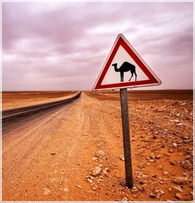
Breakfast. We start our trip to Zagora passing by a beautiful pre-desert landscape and arrive in the Draa Valley, the largest palm grove in Morocco. Afterwards we continue our trip to Zagora, a Moroccan town at the doorstep of the Sahara desert and near the Algerian border. It is situated in the Draa valley, where a river waters the marvelous palm grove forming an oasis in the middle of a deserted landscape. Even though the city was built at the foot of a fortress constructed by the Almoravide dynasty, the city wasn't founded until the French colonization. It consists of two main streets with red buildings and houses, which are home to several shops and markets, where Berber, Arab or Mauritanian Bedouins are trading. The road leads from Zagora further south and merges into a dusty and sandy desert road after a while. Small villages with traditional clay houses are scattered among the oasis. One of them is Tamegrout, in former times a religious and educational centre and famous for its desert library, which holds and perfectly maintains manuscripts from the XIII century because of the town's dry temperatures.
Day 10 : Zagora - Ouarzazate :
Breakfast and afterwards a short walk through town before we start our trip to the north. Heading towards the Saghro mountain chain and the Anti Atlas we arrive in Ouarzazate, a fertile region with perfect conditions for the agricultural sector, and where dates, roses and henna grow. A favorite destination for many movie directors, a bunch of popular movies has been produced here. This has brought some great economic growth to the region as numerous businesses and companies related to the film industry have settled in the area and offer jobs to the local people. Among the most important movies that have been produced in Ouarzazate we should mention: "Le chevalier marocain"(1887) of Louis Lumière,"Lawrence of Arabia" of David Lean,"The last temptation of Christ" of Matin Scorsese, "The Sheltering Sky" of Bernando Bertolucci, "The man who would be king" of John Houston or "Cleopatra" of Fran Rodam.
Day 11 : Ouarzazate - Ait ben Haddou - Telouet - Marrakesh: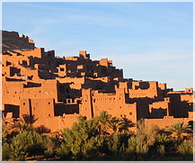
After breakfast, we visit the famous Kasbah Ait Ben Haddou, nominated world cultural heritage by the UNESCO. We head off to Telouet, taking the most beautiful roads in Morocco. Telouet is originally a former palace from the Glaoui dynasty, the Pacha of Marrakesh. After crossing the Tizi-n-Tichka pass, we finally arrive in Marrakesh.
Day 12 : Marrakesh - Essaouira :
Breakfast and departure in the morning to Essaouira, in former times also called Mogador by the Portuguese. Over the time, Essaouira has collected many nicknames, such as "The pearl of the Atlantic", "Sleeping beauty", "successfully completed" from the arabic word Souirah. A cultural heritage, it has kept the charm and authenticity of a land lost in time. It can be described as the last fortress on the Atlantic Ocean with houses reminding us of the 'white villages' of Andalusia in Spain. Visit of the city including its precious medina and fisher neighborhoods.
Day 13 : Essaouira - Marrakesh: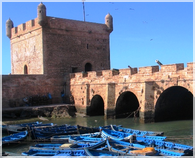
Early breakfast and departure to Marrakesh, known as 'the red city' and built in the midst of a huge palm grove, in the Haouz plain. Marrakesh was originally meeting point for the huge caravans on their way from the great sub-Saharan imperials to the Mediterranean sea. The city was founded in the XI century by the Almoravides, a people originating from the desert and who made it the country's southern capital. La Menara , la Kasbah, the Saadian tombs, the Bahía Palace, the Koutobia, the Majorelle Gardens and the souks are an absolute must-see. A unique adventure is to pass by the Djemaa El Fna square where typical habits and activities from the south are concentrated in one spot: Dancers, taletellers, jugglers, craftsmen and artists, commercials and magicians with serpents, mosques and minarets, palaces and gardens, souks and markets and even more can be found in Marrakesh!
Day 14 : Marrakesh - Tangier : Breakfast, early departure to Tanger to take the ferry to Algeciras. End of our services.